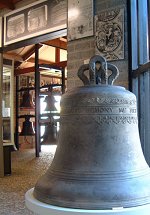
ASTEN - In August 2002, divers from the Dutch Institute for Ship and Underwater Archaeology (NISA) discovered a bell in a wrecked ship which appears to have sunk in the seventeenth century in the western part of the Waddenzee near the island of Texel. According to the inscription on the waist of the bell, it was cast in 1658 by François Hemony in his foundry in Amsterdam. The weight of the bell is 132 kg, the diameter 59.5 cm and its strike note is f2. Without doubt an exceptionally important discovery: an intact bell, almost 350 years of age and as good as new.
Channels and sandbanks move with the passage of time. Therefore, well preserved old shipwrecks frequently emerge from the sand. Through the centuries, this bronze Hemony bell, safely buried in the sand, hardly corroded and remained remarkably intact due to the absence of sulphur dioxide in seawater. Sulphur dioxide, which turns into sulphuric acid in a moist environment, lessens the thickness of the profile of the bell and influences its pitch and the tuning of the individual partials.
CHARACTERISTICS
According to several campanologists the sound of this Hemony bell is distinctly different from that of other Hemony bells known so far. Research may reveal the reason for this. Is it because bells in towers have been struck countless times? Did this influence the crystalline structure of the bronze? Or was there something unusual about the casting of this bell?
The interior of the bell shows traces of the tuning process. A sound analysis of the five lowest partials produced the following figures (in mean-tone tuning, based on f - 42 cents, if a1 = 440 Hz):
